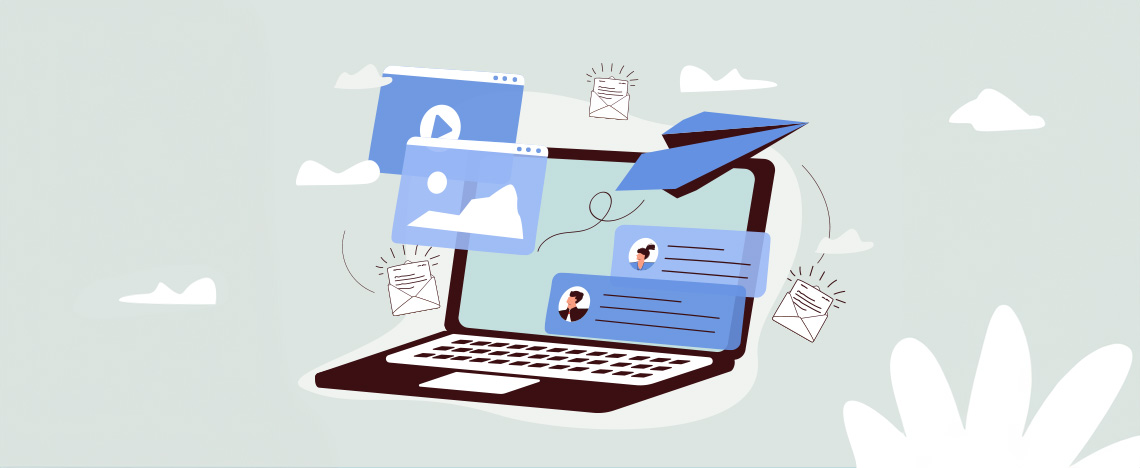

You may (or may not) remember hearing the cheery voice of Elwood Edwards calling out from your computer, “You’ve got mail!” Back then, email was new and exciting.
Now, our inboxes are so flooded with emails we get excited when we don’t see new messages. So how can email marketing fuel our overall inbound strategy in a world with too many emails?
The answer is simple but not easy to implement: Make your emails stand out with messages that speak directly to your intended audience while incorporating best practices and maximizing the most innovative technology.
My grandparents sent letters to each other when my grandfather was shipped overseas to deliver supplies during World War II. They were handwritten in cursive, which means a significant portion of today’s population wouldn’t be able to read them.
When the typewriter became a common household item, some people stopped writing handwritten letters, but they still sent letters. The method and delivery just changed.
An email is nothing more than a letter and letters will never die because they allow us to personally connect to others and say things we might not say out loud.
Marketing emails can also create a personal, emotional connection if we solve for a customer’s pain point in an engaging, interesting way, which is the foundation of good copywriting.
Just as my grandpa wrote to my grandma about things he thought she would find interesting about his overseas experience, we should personalize and segment our emails to make sure we’re speaking to our audience’s needs and interests. Instead of feeling like they are just one of thousands receiving this email, they’ll feel as if this letter was written with them in mind.
With the right keywords, hashtags, design and more, social media posts, web pages and blog posts target your intended audience, but they also bring along those who aren’t, such as students reading your medical blog as research for a paper.
Email, on the other hand, targets your intended audience directly, provided you’re keeping your database clean. These contacts have likely ended up on your contact list because they’ve either purchased a product or service, or they’ve given you their information in exchange for a case study, whitepaper or other resource.
Email is also a cost-effective, high-ROI method of connecting with this audience.
Think of this next section as a checklist to make sure you’re consistently using every tool in your email marketing arsenal so when things get hectic, you don’t leave anything out:
Is your audience more interested in watching videos and scrolling through social media these days versus reading ‘letters?’ Use email to give them more of what they want! Incorporate video and social media in your marketing emails to capture their attention and continue the conversation.
Did one of your posts get lots of engagement? Keep the conversation going through email! You can send a link to the post, getting further engagement, and even reward their efforts in some way. Maybe they complete a form, such as a quiz, on the particular topic.
Get your videos out to a larger audience by emailing an enticing clip with the link to watch the rest of the video on your website, increasing your site’s traffic.
When looking at marketing metrics to evaluate how well your email was received, there are several metrics that are worth examining, since one of these alone will not tell you the whole story.
Open Rates reveal the number of emails opened out of the total number delivered. If the number is low, look at your subject line. Did it contain the words ‘sale,’ ‘percentage,’ ‘discount’ or other sales language? Consider the send time. If you work mostly with B2B customers and you sent the email on a Friday afternoon, the open rate will probably be low. The sender information can also provide insight. If the email came from info@yourcompany.com or marketing@yourcompany.com, you’re telling the recipient this is a marketing message and they may just delete it without ever opening it.
The click-through rate tells you whether your offer was appealing enough for them to take the next step, such as watching a video or downloading a resource.
If so, did they convert by filling out a contact form in order to download your resource? If your conversion rate was low, do you need to change the price of your workshop? Build more trust with your customers?
By regularly evaluating performance, you learn how to give your prospects and customers what they actually want and use that information to inform decisions in the future.
There’s nothing more irritating than getting an email about a product you’ve already purchased or that doesn’t apply to you at all, right?
That’s why integrating email with a CRM platform such as HubSpot can help you target your customers through segmentation or lists that group customers together based on certain data, such as industry, where you got their contact information, (which tells you a lot about them) their location, customer status, etc.
Your campaigns should also target these different audience segments. The more you show you really know your customers, the better you can tailor your content and the more trust you will earn.
Customers want to feel special, because they are! You may have 100 customers or 10,000, but each is unique, and while you can’t write completely different content for thousands of customers, you can make individuals within a group or segment feel like your email was written specifically with them in mind.
As visually appealing as designed emails are, they scream ‘marketing’ email versus something personal, tailored to their needs.
Use a simple design that functions like a server in a fine-dining restaurant: someone who works quietly in the background to support your goal of having a fabulous meal. Likewise, your email’s design should add to the ease and enjoyment of reading the email without overpowering the copy. The design should support your connection with the customer, not steal the show.
Be sure to keep up with GDPR and CAN-SPAM regulations that are designed to keep businesses from sending unwanted emails to already bombarded email accounts. Even if those regulations don’t affect your business directly, it’s a good practice to act as though they do. Don’t become junk mail!
If you’re like me, you subscribe to countless newsletters and blogs, only to realize that you can’t keep up with all of the emails landing in your inbox. You’re interested, sure, but not that interested.
Your customers likely signed up for your emails to download a resource or to gain other information to make their lives easier. Sending daily emails rarely makes anyone’s life easier. But maybe your audience does want daily letters from you.
Consider letting your audience choose how often they hear from you. Do they want weekly emails? Biweekly? Monthly? None at all? Giving customers choice and making unsubscribing easy will help avoid your emails eventually being rerouted to spam due to low open rates.
You know how it felt to receive that handknit sweater from your great aunt who couldn’t really knit and had no clue about modern fashion? This is why collecting the right data and analyzing it regularly is so important. It tells you where you went wrong and gives you opportunities to give your customers what they really wanted.
Look for trends. Did a specific group of customers fall off the radar when you changed your marketing strategy or product offerings? As a B2C customer, I purchased multiple classes and products from a company until I received an email with the subject line: “I want to talk about motherhood.”
I deleted it without opening the email. What did that have to do with the product offering? And more importantly, what did that have to do with me? Zilch. Zero. Nada. I thought they knew me, and that I was in their circle. I was so disappointed to learn I no longer was.
Sometimes it makes sense to change your offerings and branding, knowing you’ll lose some customers in the process. If you made the right decision, you’ll gain many more.
If you did unintentionally exclude these customers, look at what changed, how it changed, and when.
All of these data points will give you clues about why this group of customers left and how to get them back.
However you decide to tailor your email marketing campaigns and strategies for your unique needs, think of email as the glue that pulls all of your other marketing efforts together. The personal touch of a ‘letter’ shows you’re not just out there in the digital sphere, but you’re right there in front of them, calling them by name, connecting with them in a time-honored way that will always be relevant.
Ready to take your email marketing to the next level? Let Kuno help you keep things interesting and relevant to your customers. Partner with us!
